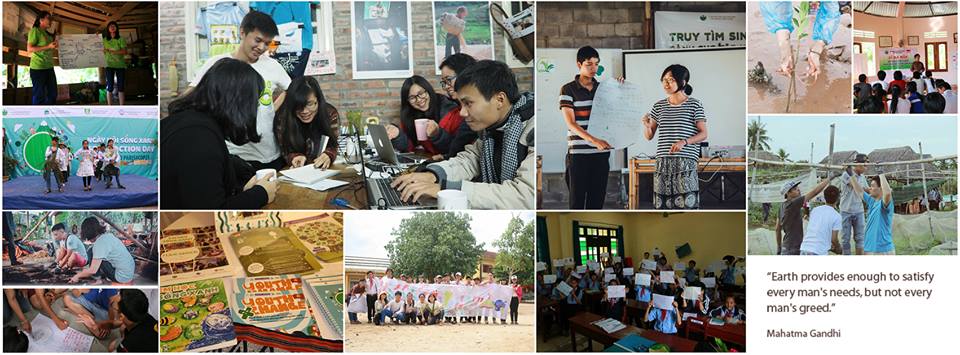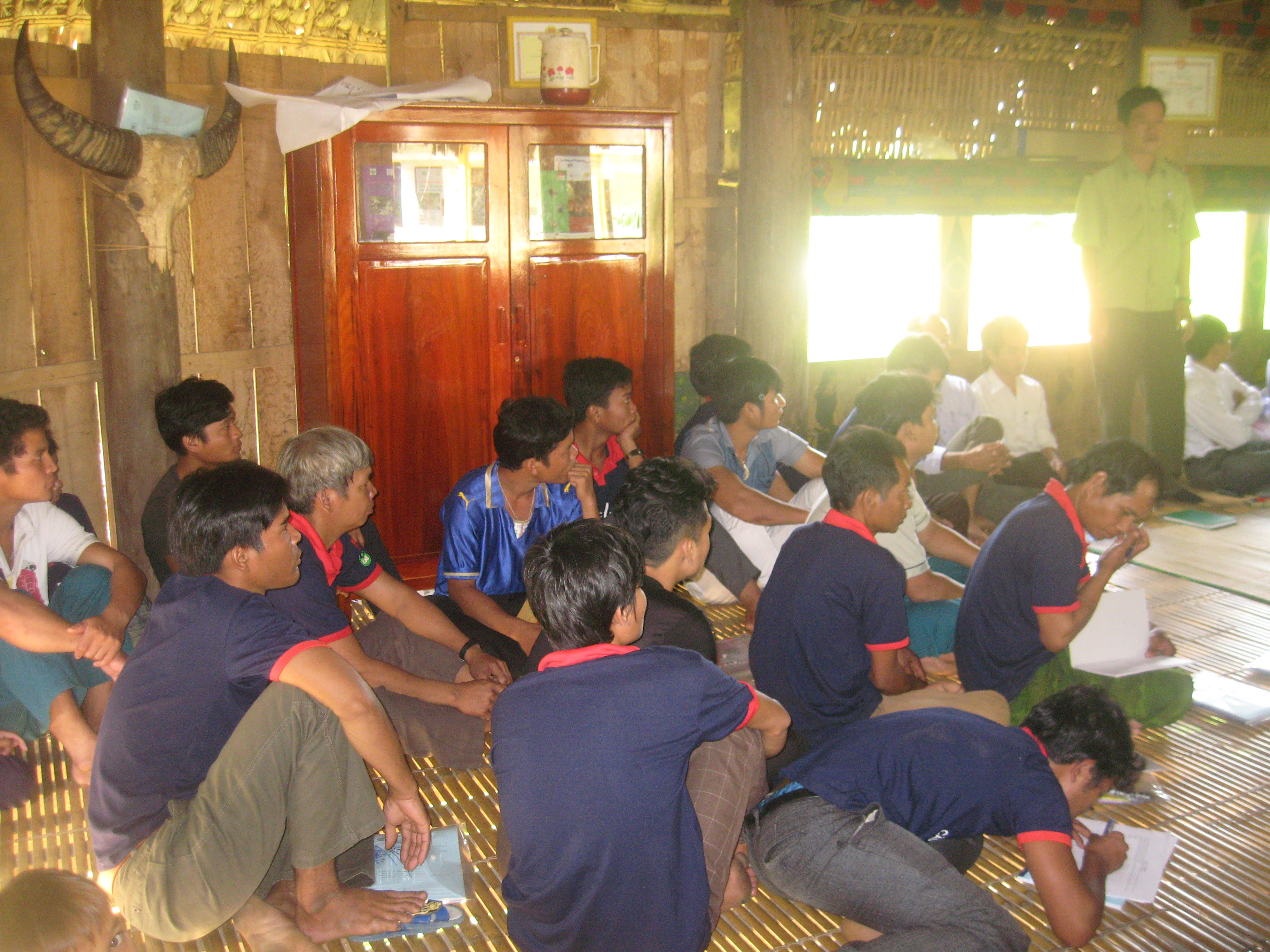Training workshop on club operation skills and dialogue on coordination of stakeholders in the management, protection and development of community forest in Xa Nghin I village
On 24/08/2013, the training of building the Regulation of Forest Protection and Development of Xa Nghin I village and skills working with all levels of authorities took place for 30 members of Xa Nghin I Environmentally Friendly Forest Use Club; 02 Za Hung commune officials (including the Chairman of the Commune People’s Committee, commune forestry officer) and 01 local forest ranger.
The development of the Regulation of Forest Protection and Development of Xa Nghin I village was very suitable because the club members are all Co Tu ethnic people therefore they know very well the customary law defined by the village community that leaded by village elders. Thus everyone is able to bring up their local customary law such as no upstream forest and sacred forest destruction, no fires in the jungle, no wild animals hunting in breeding season, no rare wildlife hunting, etc. However members also understand that the law is only applied to the Co Tu ethnic people in their village, implementation for outsiders is very difficult, especially for Kinh people coming to exploit and hunt animals in the village forest. For that reason, they need to build the village forest protection regulations to submit to the District People`s Committee for approval and implementation in order to overcome the above mentioned limitations.
The development of the Regualation received a lot of attention and participation of everybody, because they are aware that this content is necessary to protect and manage forest by households before signing contracts for forest protection with A Vuong Forest Management Board (forest owner), to know what steps to organize village meetings to spread out the policies of forest protecting allocation in their local area or to know how to recognize boundaries, status of the forest that people will soon be allocated for protection. Hence, the villagers have the foundation for community forest management and protection with high efficiency, besides, they also know how to apply the agroforestry models of in order to get more income from the forest.
Representatives of every group presented the results of group discussions following the questions suggested by the trainer. Through the reported results of all groups, they had promoted the spirit of teamwork, respected opinions of the members and the leaders had outlined suggestions for people to debate and come up with final result. This is not a strange problem for everyone but for the development of the regulation of community forest protection and development, this is a very practical matter, and it is neccessary to promote the spirit of collective contributions to create the regulation and present to Za Hung Commune People`s Committee for approval and implementation. However, because this issue is still very new, therefore people are confused and do not know how to be active in exchanging and sharing information with teachers to guide them to perform better in the coming time for local club. There are issues presented by members that still have characteristics of local customary law, not in accordance with the current regulations of the State. For that reason, in the near future, we need to organize the training and technical guidance for Club in this content to help members make the final decision in the regulation of community forest protection and development in accordance with the local customs and culture as well as the State policies.
For the content of skills on writing documents (prepare dispatches, reports, plans, …) of the club to work with other agencies and authorities at all levels
This content is essential to the club, because by far, the reports of the activities of the village are made by the village head. However, when the issue was raised, people are aware of the need of the members agreed with content suggestions, issues before making a final result. It leads to the more effective performance of content delivery, higher quality in the documents; the text makes the reader understand the issues raised by the writer and is in accordance with the provisions of law and jurisdiction of all levels.
As people’s perception, the document that sent to the higher competent level is usually easier to be approved. However, this assumption is completely contrary to the provisions of the current law because the document was sent over their right level that following the defined document dealing procedures, or sent to the units that do not have function and competence to deal with the document. Therefore, to enhance the ability of the club in the coming time, we need to have a policy for fostering and training to improve skills on writing documents for club so that they can know how to utilize the help, support and investment of individuals, units as well as the competent authority to build stronger club, improve the living standard of club members and reach the goal of sustainable protecting the local existing forests.
The majority of learners think that the contents impartation of the trainer is rich and diverse, with accompanying illustrations or citing specific model to analyze and compare with the local real examples; so that the learners feel like doing at his local, which makes them very easy to remember and apply. The learners are motivated by the trainer; they are enthusiastic to give their own opinions, exchange and share issues presented by the trainer or boldly ask about the issues that they do not understand.
Through this training, it can be seen that people need to study and exchange of information to know how to build a the Regulation of Forest Protection and Development for members inside and outside of the village joining together for the implementation of protecting and developing community forest or know how to prepare necessary documents delivered to every sector, level and unit in calling for investment and support for the club growth.
On 25/ 8/2013, the dialogue including 30 members of Xa Nghin I Environmental Friendly Forest Use Club, representatives of 18 households in Xa Nghin I village (village elders, police officers, …), Chairman of Za Hung Commune PC, commune forester and ranger in charge of the area has been organized to facilitate communities, local authorities and stakeholders to meet and discuss about the coordination and participation of involved parties in the management, protection and development of community forest. Moreover, this will help club members know how to communicate and process information in the managing, protecting and developing of community forest and responsibilities of stakeholders.
During the exchange, discussion and Q&A between the community and stakeholders to coordinate and implement the management, protection and development of community forest in village, the opinions are agreed and focused on the following issues:
To effectively and sustainably manage and protect the community forest would require the active participation of people and communities living near the forests, whose lives depend on the forest. For a long time, the role of communities in forest protection and development has been recognized in many places and bring practical results. Many CFM models are not yet recognized by law but are still good models that are capable of solving in harmony with the needs of the people and the survival of the forest.
The forest allocation to community is still inadequate in guidelines and policies and because the level of awareness of the local people is limited and the organizational capacity, management of forest at the village level is still weak. Benefits from forest still do not have specific products such as timber, non-timber forest products since the forests allocated to community are almost poor therefore should take time and money to the community can benefit from the exploitation of forest, it takes many years until the forest reach harvest volume.
The communities after being allocated to forest management, forests are still exploited, deforested and encroached. Specially, there are some community forests are cleared more than before the allocation. For communities that temporarily manage the forest following the support of several projects, when the project ends, the community is not responsible for forest protection therefore the forest is still invaded. Most of the communities that is temporarily allocated by commune through the forest protection regualtion of the village under the guidance and supervision of the forest ranger force also protect the forest area not well as the regulation commitments.
Another araising complicated problem is the forest area above after being allocated to the community is at risk of being encroached because the illegally deforestation criminals assume that communities are not capable of preventing and handling. It has occurred some situation that ousiders come and exploit illegally, while the communities have not established any forest protection groups and are not timely supported of funding and forces to prevent and handle such cases.
The first reason leading to the situation of "Everybody`s business is nobody`s business" as noted above, the villages after being alllocated but still do not protect the forest is because the allocated forest area is too large or too far from residential areas, little direct impact on the protection of the community.
The second reason is due to the sense of community in protecting the forest is not high, the role and prestige of the village elders and chiefs in the community have not been respected, the mutual self-monitoring, self-adhere to the regulation of the community forest protection is still low. Since the legal status of the community is not specific, community forest destruction can not be blamed for anyone in the community so the organizing and ability of forest protection to prevent forest encroachment from outside into community forest are not cared enough. In current, the State does not have specific provisions on the right to ultilize if protecting forests well (excluding the amount of forest growth), leading to communities still have not received benefits from forest therefore they are not interested in the protection work.
According to the opinions of members at the dialogue mentioning the reason why some communities protected rather well the allocated forest area, it is known that most of these forests are located close to residential areas and are not so large, directly protect the villages such as provide drinking water, irrigation and drainage, prevent erosion, washing, exhaustion of the soil, etc. It means the forest is directly related to the survival of communities in the region, so they must protect it.
The dialogue also agreed that there should be sustainable solutions for both mechanisms, roles, functions and responsibilities of the parties involved, such as :
In fact, in order to improve the ability of forest management and protection of the community, it is neccessary to have the support and regular supervision of local authorities and relevant agencies, especially the forest ranger force. For a more effcient land and forest allocation to community, firstly the functional units should consider the customs of villages in community activities, location and area of forests and the importance of the forests for community before setting dossiers to allocate forest to community to manage.
It should not allocated forest areas is too large or too far from residential areas, little direct impact on the protection to the village to community for management. Along with the developing community forest protection plans that have long-term sustainability, considering the sense of responsibility and the capacity of communities to protect forest before the allocation decision, limiting the massive allocation that chasing the achievement without efficiency considerations after allocation.
Before allocating forest to village communities, it is needed to build regulation of forest protection and to have long-term sustainable plans and schemes when establishing forest management board and the specialized groups to protect and manage community forest.
Communal PC and local forest ranger needs to further uphold the role of the CFM, to regularly grasp information and mobilize forces to check, raids, seizure and handle the violations in the areas of rich forest that has been allocated to community for management.
For the authorities, the functional units have to make a good communication, provide people with knowledge and practical information for the production process, to guide people to effectively apply the scientific and technical advances into production.
The functional units, especially the units that directly involve in the process of enforcement of forest protection such as forest rangers, police officers must have appropriate policies to enhance enforcement duties. Along with the increase in staffing and specialized equipment, they must focus on other basic skills such as communication, mobilizing people, skills of agricultural and forestry extension and other issues of professional expertise. The State should also have the appropriate incentive policies to attract and encourage functional units’ staff to stick to local areas, love their job and dedicate their best to the forest protection.
The above solutions to the economic and society have the purpose of improving the living standard for people, decreasing the pressure of people on the forest, giving people the habit of using alternative products replacing the traditional products that have been generated from frorests for a long time, a long with creating sustainable development both in terms of ecological environment and the economy, helping people benefit from forest in a long-term and scientific way.
In the dialogue, members have given their opinions, shared and exchanged information on challeging issues to the protection of local existing forests. Through the relatively good exchange of forest management in village, there used to be people from outside the village coming into the forest of Xa Nghin I village to exploite timber illegally, but this exploitation was discovered by villagers and reported to Dong Giang Forest Protection Unit to coordinate and seize about 13m3 of different kinds of timber. Currently, the illegal logging basically no longer happens in the hot spots of the village. However, there are still outsiders come to exploite timber illegally in small scale, transported by motorbike. Thus, through the dialogue, the feedback information about the forest protection in Xa Nghin I need attention, coordination, information exchange, grasping the situation to handle the illegal logging and transporting of timber.





